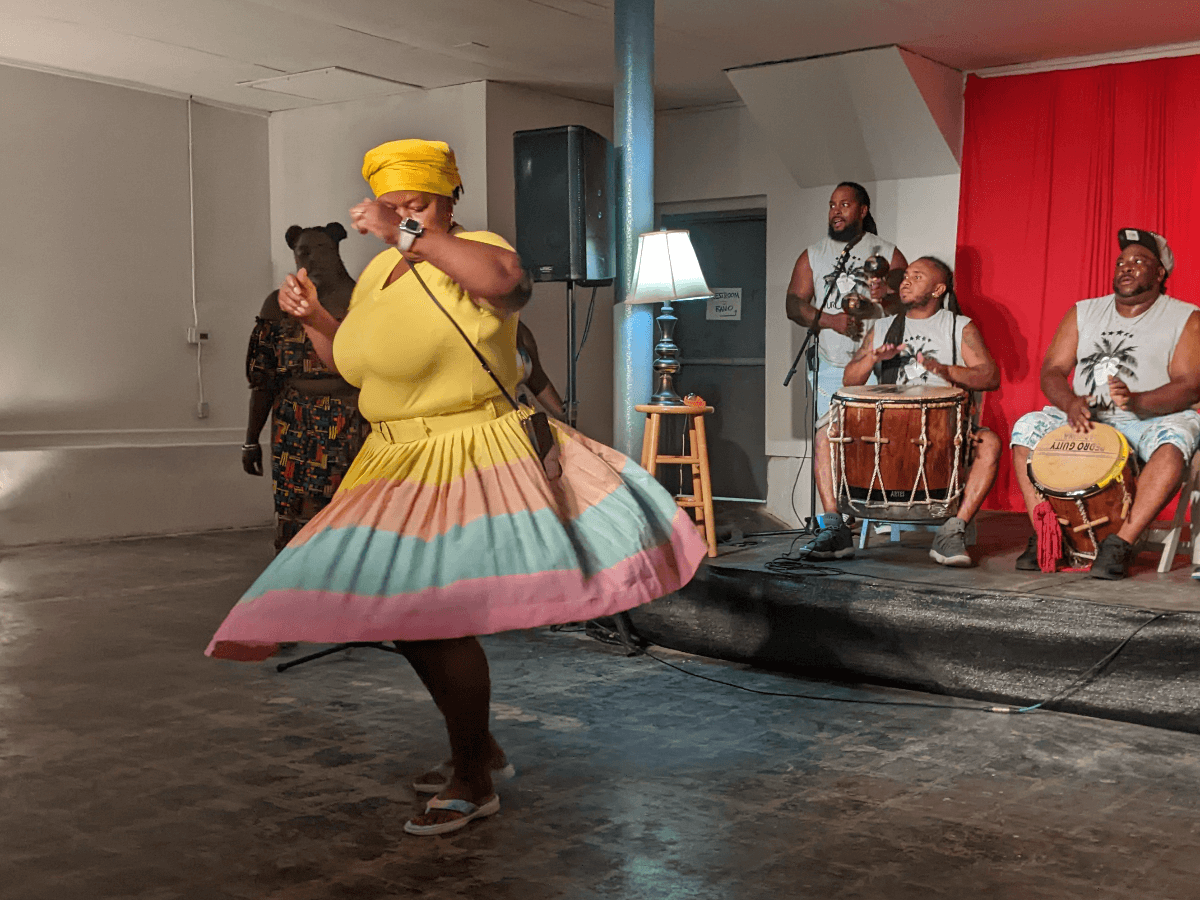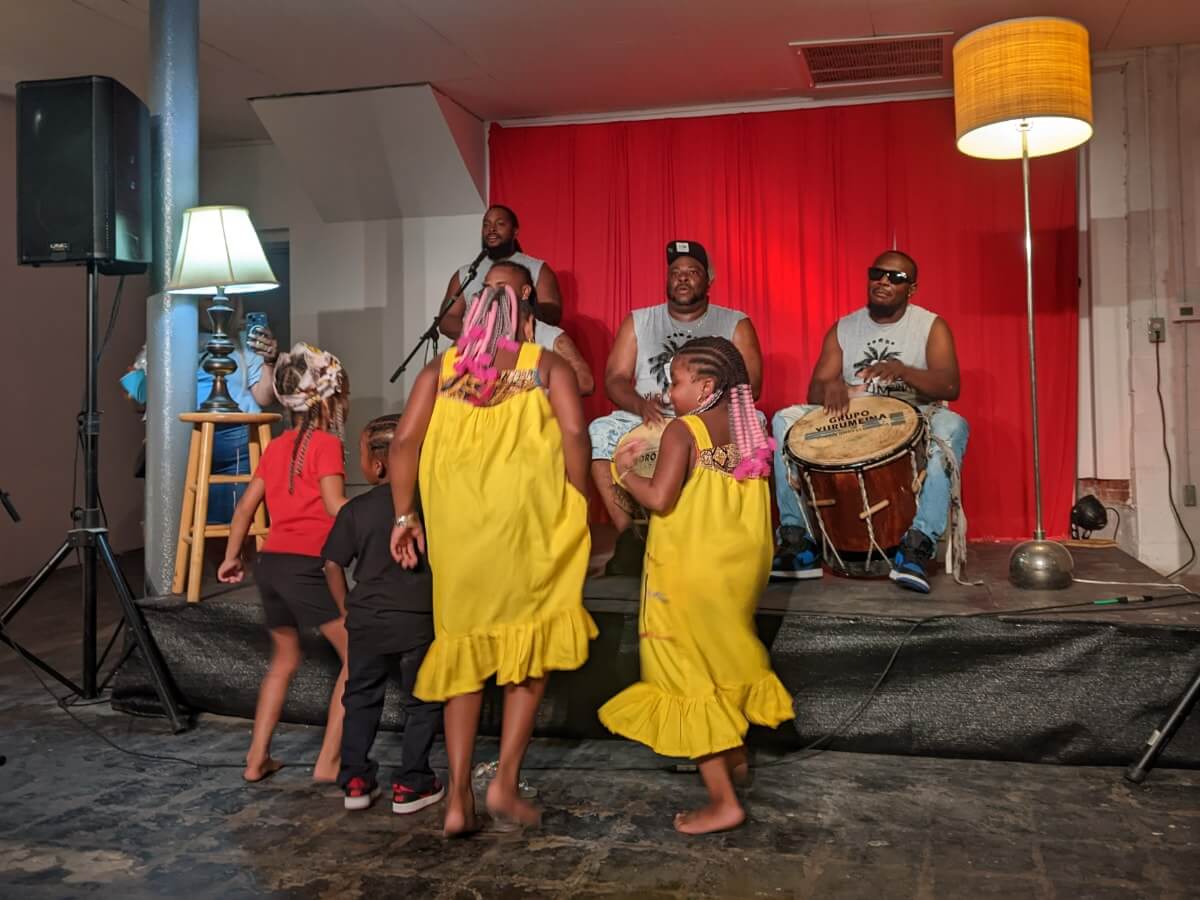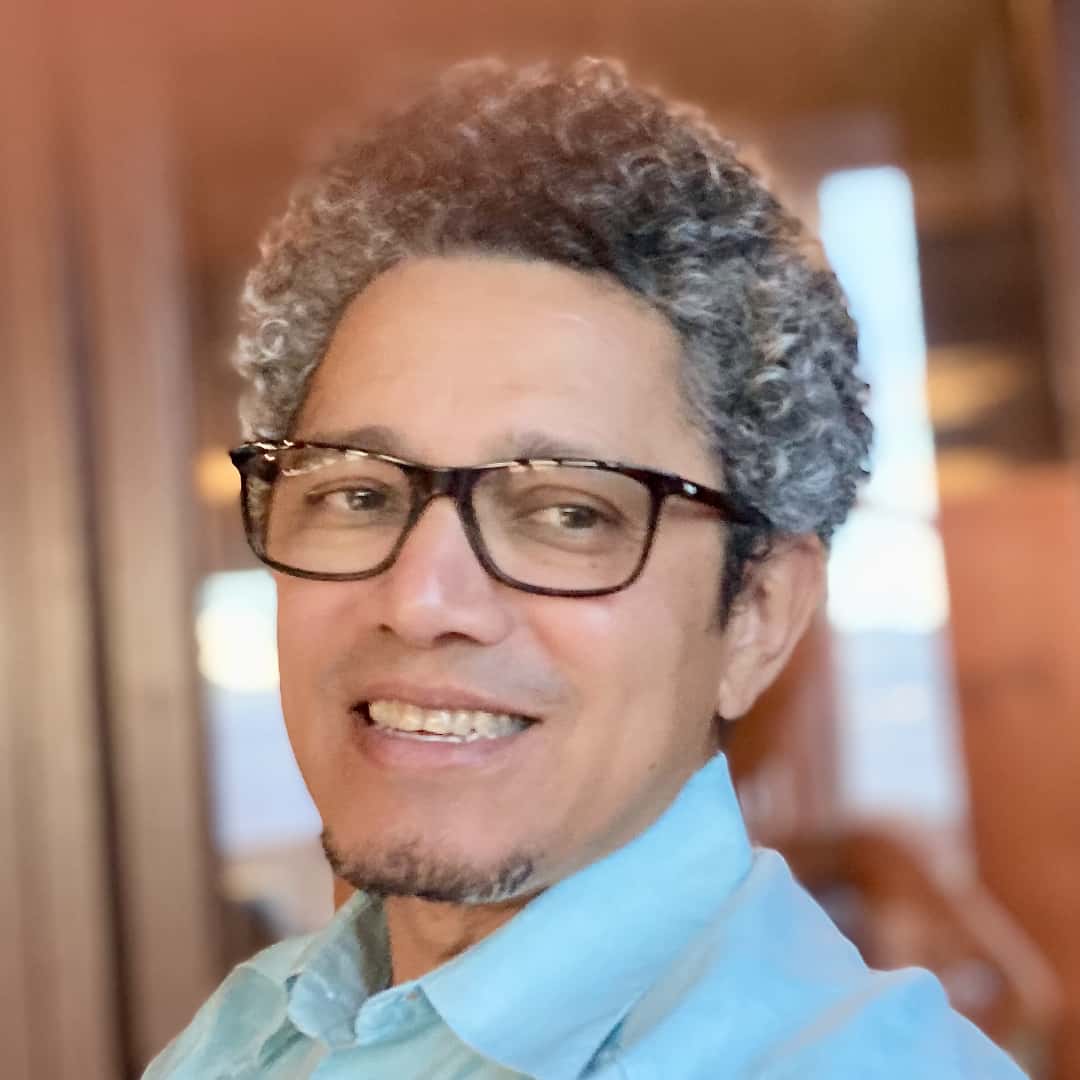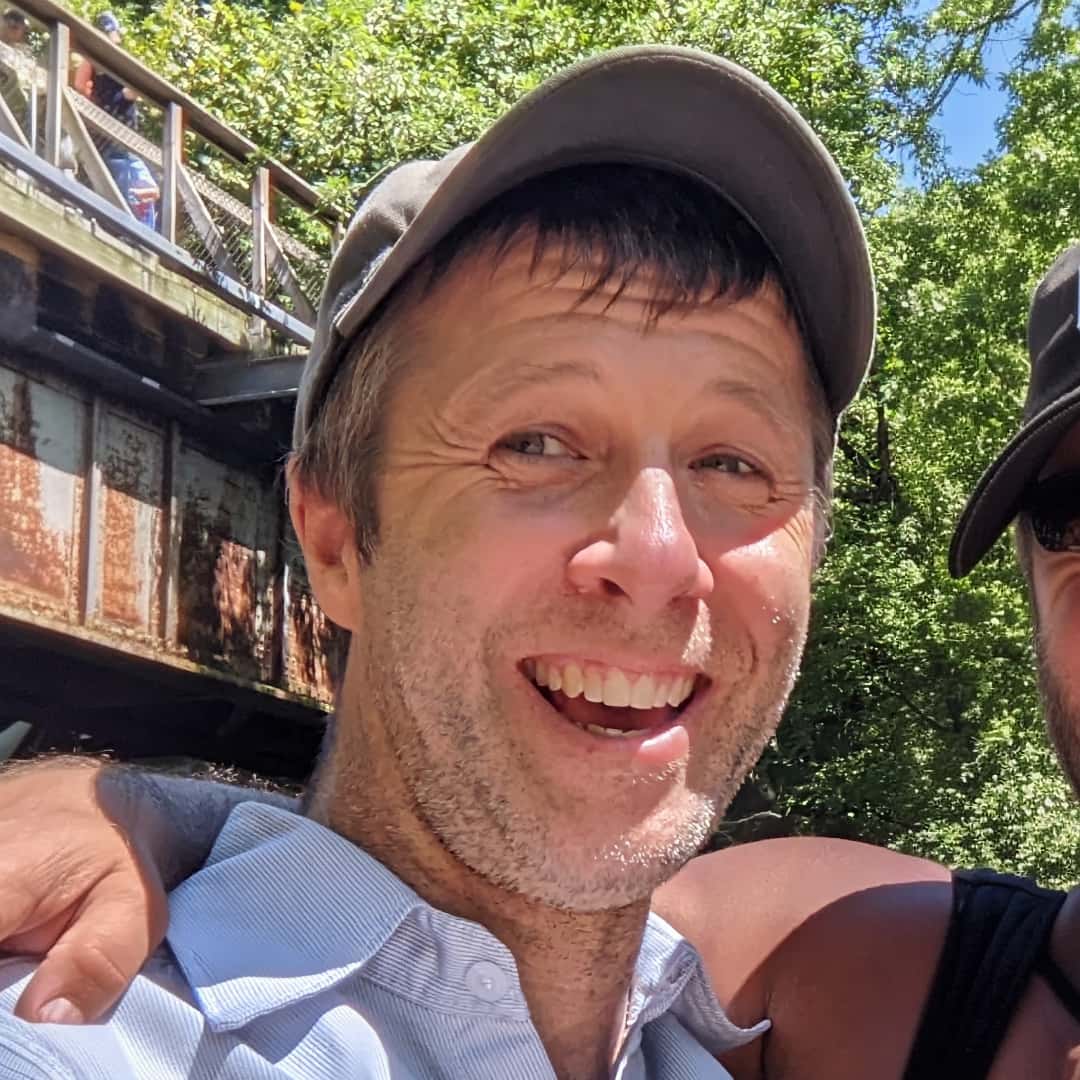CANOA:
Bridging Cultures and Building Community in New Orleans
By Carey Fountain
• 6 minute read

Southern Artists for Social Change awardee Carey Fountain writes about fellow awardee Caribbean and New Orleanian Arts (CANOA) and its founders, Tomás Montoya and Jebney Lewis.
In a vibrant neighborhood of New Orleans, an innovative project named Caribbean and New Orleanian Arts (CANOA) is reshaping the cultural landscape by fostering connections between local communities and the Caribbean diaspora.
At the heart of this initiative are Tomás Montoya and his project partner, Jebney Lewis. Together, they have created a dynamic space that serves as a lab, living room, gathering space, and dance floor, where artists, scholars, and culture bearers from the Caribbean and New Orleans come together to celebrate and preserve their shared heritage.
The Genesis of CANOA
The inspiration for CANOA traces back to Tomás Montoya’s arrival in New Orleans from Santiago de Cuba just before Hurricane Katrina.
Tomás was struck by the cultural and historical similarities between New Orleans and Santiago. Recognizing these connections, he dreamed of creating a physical location where the Caribbean diaspora could gather and engage in artistic and cultural exchanges.
“People would say two things about New Orleans,” Tomás recalls. “There’s no city like this in the world, and it’s the northernmost Caribbean city. I felt there were cities a lot like New Orleans, specifically in the Caribbean, and wanted to explore those connections.”
Jebney, with a rich background in theater, event production, and venue management, met Tomás through their wives, who are best friends. Over coffee meetings, they began to brainstorm how to bring CANOA to life. Despite challenges such as Hurricane Ida, the pandemic, and even a fire, they persevered, transforming their vision into reality.
Engaging the Garifuna Community

A significant focus of CANOA is its collaboration with the Garifuna community, an Afro-Indigenous group with roots in St. Vincent Island and a significant presence in Honduras, Belize, and Guatemala.
This community has a long history in New Orleans, dating back to the early 20th century, largely due to the banana trade facilitated by the United Fruit Company.
Jebney’s personal connection to the Garifuna people began with his stepmother, Norma, who is Garifuna. He spent considerable time in Garifuna communities in Honduras and maintained casual connections with the Garifuna community in New Orleans. During the pandemic, Jebney initiated a project called “Letters from the Porch,” which featured local musicians performing safely on their porch fronts. This project included a video with the Garifuna traditional band, Grupo Yurumeina, marking the beginning of a formal relationship.
Grupo Yurumeina, led by Pedro Guity, and Bernardo Guerrero, a Garifuna historian and cultural advocate, have become integral to CANOA’s mission. These collaborations have resulted in events and programming aimed at preserving and broadcasting Garifuna culture more widely in New Orleans.
During the pandemic, Jebney initiated a project called “Letters from the Porch,” which featured local musicians performing safely on their porch fronts.
Overcoming Challenges and Building Trust
One of the primary challenges in working with the Garifuna community has been overcoming mistrust and internal divisions.
The Garifuna community in New Orleans is fragmented, with groups often organizing activities within their own circles based on regional ties to various towns in Honduras.
To address this, CANOA has emphasized radical transparency and inclusive decision-making. In their initial meetings, Jebney and Tomás shared the project budget openly with community members, fostering trust and ensuring everyone understood how resources were allocated.
“The creation of a safe space is crucial,” says Jebney. “We want people to feel they can air their conflicts and work through their differences. It’s about providing support and creating an environment where everyone can come together.”
Measuring Success and Looking Ahead

For CANOA, success is multifaceted.
One key metric is sustained engagement with the Garifuna community beyond the grant period. They aim to create an ongoing engine of cultural production, with continuous programming and events that highlight Garifuna music, dance, and culinary traditions in the wider New Orleans community.
“We want to see more people speaking, writing, and reading Garifuna,” Jebney explains. “Our goal is to elevate the profile of the Garifuna community and integrate their unique cultural contributions into the broader cultural fabric of New Orleans.”
Advice for Community-Based Artists
Reflecting on their journey, Jebney and Tomás offer valuable advice for artists seeking to engage in community-based work.
Transparency and authenticity are paramount. “You need to be real with people and yourself,” Tomás emphasizes. “Present what you can do honestly and build trust step by step.”
Jebney adds, “Community-based work requires serving the community genuinely. Be prepared for the project to take longer than expected, and always be ready to adapt and listen to the community’s needs.”
* * *
CANOA stands as a testament to the power of art and cultural exchange in bridging communities and preserving heritage. Through their dedication and collaborative spirit, Jebney and Tomás are not only enriching the cultural landscape of New Orleans but also creating a model for how communities can come together to celebrate and sustain their shared histories. As CANOA continues to grow, it promises to be a beacon of cultural resilience and unity in the heart of New Orleans.
About Tomás Montoya
Tomás Montoya González is from Santiago de Cuba and has lived in New Oeans since 2004. He is a photographer, poet, arts organizer, teacher, researcher, and co-founder of Caribbean and New Orleanian Arts (CANOA). Before moving to the U.S., he spent 10 years as president of the Asociación Hermanos Saiz, a nonprofit organization for artists and intellectuals in the Province of Santiago. While there, he worked to launch important community art projects, such as Ennegro, which explored themes of environmentalism, Afro Cuban and Haitian religion, vernacular music, and visual art. Through this work, Montoya ended the organization’s previously elitist tradition and affiliations and expanded its focus to include offerings rooted in popular culture and traditional, Afro Cuban art forms. Since 2001, Montoya has been documenting and filming the “Congas” of Santiago de Cuba, the biggest street parades in Cuba. He was a finalist for the New Orleans Photo Alliance’s Michael P. Smith Fund for documentary photography in 2012. His research inspired the making of the film, Lazaro & The Shark: Cuba Under the Surface, on which he served as an executive producer. The film has been shown at festivals in New York, Munich, Krakow, and Brussels. Additionally, Montoya served as an adjunct professor in the Spanish and Portuguese Department at Tulane University from 2008 to 2014. Montoya has coordinated several international encounters focused on examining Cuba’s culture with the CubaNola Collective and worked as an advisor and assistant producer for the 2017 New Orleans Jazz and Heritage Festival, which was dedicated to Cuba.

About Jebney Lewis
Jebney Lewis (jebneylewis.com) is a sculptor, set designer, community artist, curator, musician, and co-founder of Caribbean and New Orleanian Arts (CANOA). He works with neighbors, youth, and other artists to re-interpret local sites and histories through the lenses of the visual and performing arts. His work has been presented at the Big Ears Festival (Knoxville, TN), Creative Alliance of New Orleans, The Albert and Tina Small Center for Collaborative Design (New Orleans), A Studio in the Woods (New Orleans), The Contemporary Arts Center of New Orleans, Temple Contemporary (Phila), VCU’s School of Architecture and Design (Charlottesville, VA), The Schuylkill Center for Environmental Education (Phila), The Philadelphia International Festival of the Arts 2013 (Phila), Christ Church Philadelphia (Phila), The Nexus Gallery (Phila), Bumbershoot (Seattle), Stripa Mine (Sweden), Aarohi (India), and various streets, lots, and intersections in a variety of other places. Jebney is also an event producer, cultural organizer, and a theater technician and designer. He co-curated a festival of experimental music, sound art and sonic sculpture at the Contemporary Arts Center of New Orleans, called Southern Sonic. Jebney has designed sets for the productions of KindHumanKind (New Orleans), The Mutilated (New Orleans), Chicken (Philadelphia), and Boom Bap Tourism (Philadelphia.) He has worked as Technical Director and/or Facilities manager for the Rivers Institute, Prospect New Orleans, The New Orleans African American Museum, the Contemporary Arts Center of New Orleans, Christ Church Philadelphia, and the Richard Hugo House in Seattle.

About Carey Fountain
Carey Fountain is a multidisciplinary artist, musician, and cultural strategist based in Alabama, known for transforming conversations into interactive art. As the founder of Vibes & Virtues, he merges music, visual art, and community engagement to inspire dialogue and social change. Fountain’s work – from his self-produced hip-hop/gospel-inspired music projects to civic art initiatives – challenges norms and uplifts new perspectives. He currently serves as Director of Programs & Partnerships at Selma’s Foot Soldiers Park, designing creative programs that honor history and empower communities. Whether through soulful music performances, thought-provoking card games, or public art installations, Carey Fountain strives to leave the world more positive and connected through art.
Photo: Amarr Croskey for Birmingham Times.
